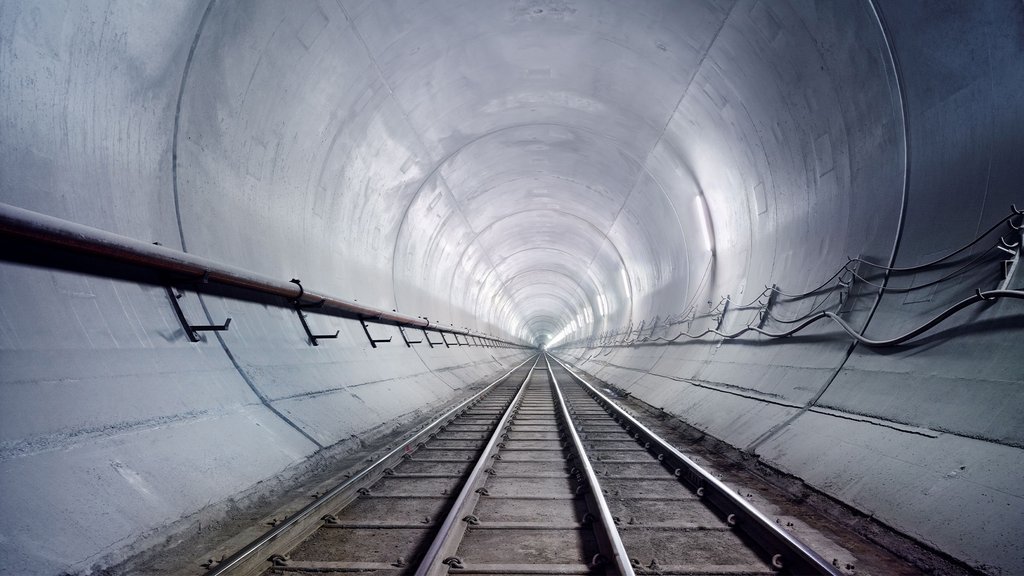Opinions - 26.05.2021 - 00:00
Five years of the Gotthard base tunnel
An almost perfect realisation and silently regular operations: five years ago, the Gotthard base tunnel was fittingly inaugurated. A look back by Wolfgang Stoelzle.

26 May 2021. Hard to believe – was it really only five years ago that the Gotthard base tunnel, the centrepiece of the New Railway Link through the Alps (NRLA) was opened with great ceremony? Railways have been travelling through this masterpiece of Swiss engineering as reliably as the well-known clockwork of the same provenance for a long time. And this means that the NRLA suffers from the same fate as achievements in transport and logistics in general: whatever works perfectly is hardly appreciated by the general public. Bearing this in mind, a review of the last five years should pay attention to something in particular: it is actually quite mind-boggling how absolutely perfectly this mega-project was realised, right down to the silently regular operations. But what is the occasion for this almost nostalgic hymn?
NRLA: New Railway Link through the Alps or Never to be ReaLised Again?
The roots lie back in the early 1990s: the then Federal Council recognised with a great deal of far-sightedness that in the light of the strongly increasing transport volume along the transalpine axis, a modal shift from road to rail would only be possible if there was a new, high-performance railway line. It was clear that this would require an enormous investment volume from the public purse. It was not only unclear, however, whether in the case of the main construction – the Gotthard base tunnel – the tubes could be bored right through the mountain at all, but also whether the neighbouring countries Germany and Italy would manage to modernise their connecting routes lines and adapt them to the new capacity cross section in time as well. Nonetheless, the Federal Council showed unusual courage and made a decision in favour of this prestigious project in a short time despite these risks and others. Particular applause, however, is due to the time in which the project was realised – only about 25 years for the Gotthard base tunnel, which is more than 50km long, and just over another four years for the technically demanding Ceneri tunnel. Why must we sing this aria? Today, the mere realisation of a simple motorway access in Switzerland takes 25 years from the first public plans to its opening! Other large-scale projects – such as Cargo sous terrain in Switzerland and the Berlin Brandenburg Airport, the Stuttgart 21 railway project and the further dredging of the Elbe in Hamburg in Germany – are finalised several years later than planned, combined with budget overruns of often more than 200 per cent.
Large-scale projects: poor performance despite technological progress
What are the reasons for this discrepancy? Despite technological progress and digitalisation, performance in large-scale projects in transport infrastructure markedly deteriorates, sometimes so badly that you simply lose your faith in such projects. This is unlikely to be caused by the project management tools or by the technologies available for precise tunnel construction. Apparently, the mentality of politicians responsible for such projects has radically changed: risks are overvalued rather than weighed up with balanced far-sightedness, and risks are certainly not run in connection with personal responsibility at all. In this context, a comparison with the current corona measures policies suggests itself: the political generation of the early 1990s weighed up the risks of all the measures extensively, communicated their decisions professionally while at the same time bolstering the population with messages that would engender trust, instead of, say, banning travel and freight transport across the Alps because of a threat of traffic congestion. Conversely, today’s politicians primarily stoke up perpetual fear in conjunction with prohibitive measures. Courage and future prospects can definitely not be inspired in this way.
Independently of changes in political culture, planning permission procedures are likely to be a driver for the fact that today, a large-scale project would probably take twice the time to be realised: grassroots democracy entails loops with a multitude of possible objections that can be lodged, and this delays planning procedures immensely. In Germany, the planning costs of infrastructure projects have meanwhile risen to about two thirds of the overall project costs. It is questionable whether this planning permission complexity, which is hardly manageable any longer, correspondingly increases the additional benefit. This may at least be doubted, for the substantial realisation delays have a negative impact on the cost-benefit balance.
Climate protection: shift onto the railways and inland waterways
What, then, are the messages of the NRLA, transposed to the present day and its challenges for transport? Never before have there been such intensive and urgent discussions about the climate, its warming and the necessity of reducing CO2 emissions. If we do not want to give up our much-appreciated prosperity for these goals and thus want to make global trade possible in the future, too, continental freight transport will require massive efforts to shift it onto the railways. This is why the European Green Deal also establishes guidelines for all the actors in the transport sector. Here, multimodal transport is in the vanguard merely because there is no alternative to pre- and post-haulage runs on the road. Therefore long main runs must be shifted onto the rails and – where possible – onto inland waterways. Swiss railway track infrastructure has at least provided impressive evidence of this. Now we need substantial efforts for the connecting tracks outside Switzerland and the retrofitting of the terminal landscape. This will be followed by possibly the greatest challenge: to make decision-makers in companies and politics return to what is now a new way of thinking, but which used to be the norm – in the spirit of “We can only achieve this shift together – so let’s tackle it.”
Prof. Dr. Wolfgang Stoelzle is the Managing Director of the Institute of Supply Chain Management at the University of St.Gallen and a member of the Board of Academic Advisers to the Federal Minister of Transport and Digital Infrastructure in Germany.
Photo: KEYSTONE/LAIF/Berthold Steinhilber
More articles from the same category
Discover our special topics











